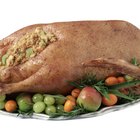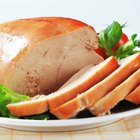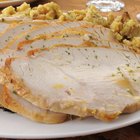ALLEKO/iStock/GettyImages
Even a small turkey requires a substantial investment in cooking time, and results in lots of leftovers unless you're feeding a crowd. Cooking a small turkey breast rather than a whole bird shaves hours off the process, and makes it a practical everyday option rather than something you'll postpone until the holidays. It's best when simply roasted until its skin is golden and the center reaches a food safe temperature.
Brining the Breast
Brining a turkey keeps the flesh remarkably moist, and doesn't add a salty flavor. Unless you're on a very low sodium diet, an occasional brined turkey breast is a healthy choice. The day before you intend to cook the turkey, prepare a brining solution of water, salt, brown sugar and herbs. Place the breast in the cold brine and refrigerate the container overnight. When you're ready to cook the turkey, remove it from the brine, rinse it and pat it dry.
Preparing A Small Turkey Breast
Rinse the breast and run your fingers over the skin to check for stray feathers, extra fat or bits of bone that made it through processing. If your family isn't counting calories or fat, make an herb butter by combining butter with herbs like rosemary or thyme or with a ranch seasoning mix. Slide your fingers between the skin and the flesh of the bird and gently form a pocket for the herb butter. Place the butter in the pocket and press it flat. If you have dietary restrictions, skip the herb butter, and remove the skin. Rub a little heart-healthy olive oil onto the turkey breast and sprinkle it with pepper and fresh herbs or a dry salad dressing mix.
Roasting the Breast
Preheat the oven to 375 degrees. Put the turkey breast in a roasting pan lined with aluminum foil. If you have a probe thermometer with an alarm, insert it into the thickest part of the breast. Roast the breast until the thermometer reads 165 degrees. If you don't have a thermometer, stick the tip of a sharp knife into the thickest part of the breast and press the blade of the knife downward from the hole gently. Clear juices indicate that the breast is cooked. Turn the breast once while it's roasting. It should be finished in 45 minutes to an hour.
Carving and Serving
Let the turkey breast rest on your carving board or a platter for about 10 minutes before you slice it. This allows the juices in the breast to redistribute evenly as the meat cools, assuring that there are no dry parts. Use a very sharp knife to slice the turkey so you don't squeeze the juices out and cut the meat across the grain so it doesn't crumble as you slice it. Transfer the sliced meat to a clean plate before serving.
Related Articles

How to Roast a Split Turkey
The Best Way to Cook a Honeysuckle ...

The Best Ways to Inject Turkey to Make ...

How to Keep Turkey Moist

How to Marinate BBQ Chicken Thighs & ...

How to Roast Turkey in a Crock Pot

How to Cook a Wild Goose in a Slow ...

How to Bake Goose Breasts

How to Cook a Turkey Leg & Breast

How to Cook a Boneless Turkey in the ...

How to Cook Turkey Legs on the Grill

How to Cook a 15-Pound Rib Roast
Easy Cornish Game Hen Meals

The Best Way to Cook Turkey Thighs

How to Reheat Sliced Turkey

How to Cook a Turkey for Shredded ...
Ideal Turkey Cooking Time by Weight

How to Make a Blackbuck Antelope Roast

How to Make a Turkey Baster

How to Cook Smothered Turkey Wings
References
Resources
Writer Bio
Meg Jernigan has been writing for more than 30 years. She specializes in travel, cooking and interior decorating. Her offline credits include copy editing full-length books and creating marketing copy for nonprofit organizations. Jernigan attended George Washington University, majoring in speech and drama.